Civic Engagement Test 1
1/41
There's no tags or description
Looks like no tags are added yet.
Name | Mastery | Learn | Test | Matching | Spaced |
|---|
No study sessions yet.
42 Terms
Refers to the ways in which citizens participate in the life of a community in order to improve conditions for others or to help shape the community’s future.
Can take many forms, from individual volunteerism, to organizational involvement, to electoral participation.
It can include efforts to directly address an issue, work with others in a community to solve a problem, or interact with government institutions.
What is ‘civic engagement’?
True
It involves working to make a difference in the civic life of one’s community.
Allows you to develop the combination of knowledge, skills, values, and motivation to make that difference.
True civic engagement allows us to work with the people in our community and collaborate to imagine how it might look different, to challenge power, dismantle it, and change the world.
True or False: civic engagement is action-oriented.
Plays a valuable role in shaping how we learn to interact with our community and develop the sense of empowerment necessary to become active citizens.
Support people and causes in our community and improve the quality of life for others.
Can give you a chance to develop new skills and team up with a diverse group of people.
How does volunteering help us with civic engagement?
More than half.
Many more rely on volunteers to supplement staff.
12.7 million volunteers contribute close to 2 billion hours.
How many of Canada’s 170,000 non-profit and charitable organizations have no paid staff and rely solely on volunteers?
Any non-profit organization that exists to perpetuate itself.
Ex: Philanthropy. The way philanthropic funds are spent produce very surface level change. For example, it makes poverty more “manageable” for the people effected, rather than acting to eradicate it entirely. The same methods are employed time and time again, despite yielding lackluster results, because there are entire industries that rely on the perpetuation of social issues.
An example of an industrial complex, NOT a non-profit industrial complex, is the military. “The military industrial complex doesn’t exist to create peace; it has to have war in order to exist.” (0:10)
What is the ‘non-profit industrial complex’?
A critical approach to social justice refers to specific theoretical perspectives that recognize that society is stratified (i.e., divided and unequal) in significant and far-reaching ways along social group lines that include race, class, gender, sexuality, and ability. (via newdiscourses)
Along social group lines that include class, race, gender, sexuality, and ability.
Recognizes inequality and injustice as structural in nature and seeks to change this.
Being civically engaged requires us to think about the problems in our world and how we might go about fixing them But in whose image should the world be changed? This is why we need the concept of social justice.
Using a Critical Social Justice lens, we will learn how privilege, oppression, power, and economic and political forces shape our world and how it may come to change.
What is ‘critical social justice’, and why do we need it?
Everyone operates from a basic theory about how the world works. Most of us don’t consider this when forming our opinions about the world and so we lack theoretical consistency.
Social justice advocates need to be able to argue well. Having a consistent and logically sound theoretical foundation allows us to do this.
Consider on whom the responsibility falls, the individual, or the collective? The government?
Why do we have to have a strong theoretical foundation to be consistent in how we view the world and apply concepts to it?
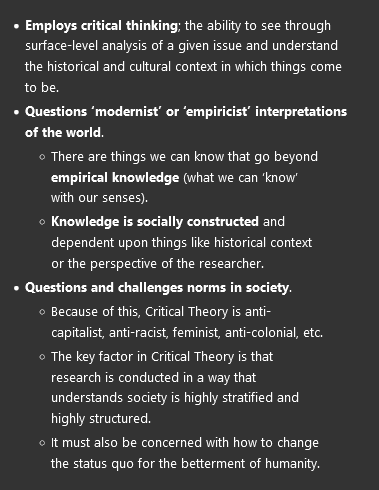
Employs critical thinking; the ability to see through surface-level analysis of a given issue and understand the historical and cultural context in which things come to be.
Questions ‘modernist’ or ‘empiricist’ interpretations of the world.
There are things we can know that go beyond empirical knowledge (what we can ‘know’ with our senses).
Knowledge is socially constructed and dependent upon things like historical context or the perspective of the researcher.
Questions and challenges norms in society.
Because of this, Critical Theory is anti-capitalist, anti-racist, feminist, anti-colonial, etc.
The key factor in Critical Theory is that research is conducted in a way that understands society is highly stratified and highly structured.
It must also be concerned with how to change the status quo for the betterment of humanity.
How do we define “critical” in theoretical tradition?
No one perspective is right or wrong—they are both right depending on one’s perspective and understanding of the world.
However, this surface level reading of the parable misses a crucial aspect— power
What was the lesson behind Hodja and The Foreigner?
NOTE: I tried so hard to look for a video, but I couldn’t find one, nor the one we used in class, and the slides for this week were only accessible in PDF format :(
A theoretical perspective which aims to critique, challenge, and reorganize dominant institutions in a manner which emphasizes justice for those who have been historically marginalized and oppressed. Specifically, Marxism critiques, challenges, and seeks to deconstruct capitalism as the central organizing structure of our society and replace it with a more egalitarian, just, and fair system.
The capitalists profit off the surplus value of labour provided by the workers. This exploitation is at the root of the capitalist system.
The world is divided largely into two classes, the
bourgeoisie and the proletariat— the capitalist class and the working class.
The bourgeoisie own the means of production. The
proletariat subsists only by receiving wages for work.
What is ‘Marxism’?
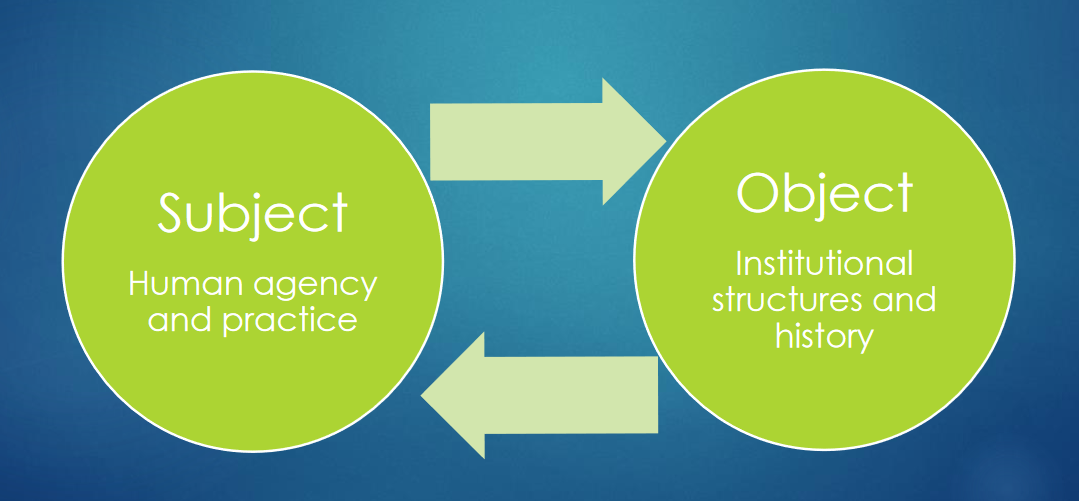
Regular and mutual relationships, interactions, and processes in nature, society, and human thought. A dialectical relationship is a relationship in which two phenomena or ideas mutually impact each other, leading to development and negation. (Wikipedia)
Critical theorists borrow from this theory to understand how societies change.
What is the ‘dialectic’?
A sociopolitical educative tool that engages learners in questioning the nature of their historical and social situation, which Freire addressed as "reading the world". (Wikipedia)
With a critical consciousness, we can perceive social reality “not as a closed world from which there is no exit, but as a limiting system which we can transform.”
What is a ‘critical consciousness’, according to Paolo Friere?
Understanding this allows us to not just diagnose problems with society, but allows us to imagine how it might be different and to actively work toward that goal.
It’s not as easy to say “racism is bad and perpetuated by racist people.” Social injustice lies much deeper than that. It is institutional, systemic, deeply embedded- built into the fabric of the system.
CSJ looks past anecdotal evidence and examines patterns and structures and actively looks to challenge, dismantle and replace those structures.
What does critical social justice do to our ability to view the world and its problems?
Refers to market-oriented reform policies such as "eliminating price controls, deregulating capital markets, lowering trade barriers" and reducing, especially through privatization and austerity, state influence in the economy. (Wikipedia)
All societies are constrained by the limitations of their epoch (a period of time in history or a person's life, typically one marked by notable events or particular characteristics. via Oxford Languages) or relation to the mode of production. Think for example of feudalism, colonial slavery, early capitalism, tribal, nomadic, etc.
Each form of society is guided by a hegemonic (dominant) philosophy which sets the tone and range of activities for all government, corporate, and social realms.
What is ‘neoliberalism’?
False.
Liberalism, at least in North America, is a strategy with the aim of reducing or preventing social conflict.
It is presented as “progressive” or “leftist” compared to conservative or right-wing ideologies. In reality, political liberalism is largely “status quo” politics and does not represent progressive or leftist ideals in their truest sense
The root of neoliberalism is economic liberalism, which is not the same as political liberalism.
Conservative politicians who say they “hate liberals” are referring to political liberals. In economics, most of those same conservatives would be considered economic liberals or neoliberals.
True or False: The term ‘neoliberalism’ is interchangeable with ‘political liberalism’.
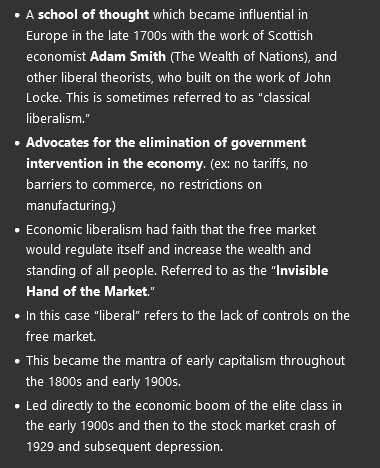
A school of thought which became influential in Europe in the late 1700s with the work of Scottish economist Adam Smith (The Wealth of Nations), and other liberal theorists, who built on the work of John Locke. This is sometimes referred to as “classical liberalism.”
Advocates for the elimination of government intervention in the economy. (ex: no tariffs, no barriers to commerce, no restrictions on manufacturing.)
Economic liberalism had faith that the free market would regulate itself and increase the wealth and standing of all people. Referred to as the “Invisible Hand of the Market.”
In this case “liberal” refers to the lack of controls on the free market.
This became the mantra of early capitalism throughout the 1800s and early 1900s.
Led directly to the economic boom of the elite class in the early 1900s and then to the stock market crash of 1929 and subsequent depression.
What is ‘economic liberalism’?
British economist John Maynard Keynes recognized that liberalism was not the best formulation for capitalism to thrive. Instead, Keynes suggested that full employment is necessary for capitalism to grow.
Full employment would never happen under liberal economics and must therefore be controlled by governments and central banks.
Keynesian Economics had a heavy influence on U.S. President Franklin Delano Roosevelt’s “New Deal” which emphasized the government’s role in advancing the common good while retaining capitalism as the central economic organizer of American society
Strengthened and encouraged a unionized workforce which minimize rampant inequality (though it still had its prejudiced exclusions).
What is ‘embedded liberalism’ or ‘Keynesian era liberalism’?
Economic liberalism.
A concerted effort by the corporate and political elite to return to the glory days of liberalism, where decreased workers’ rights and a focus on the highest possible profit would mean a better life for the rich and powerful.
Upheld by powerful financial institutions such as the International Monetary Fund (IMF), the World Bank, and trade agreements (NAFTA, WTO, TPP, etc.) which lessen the power of governments and citizens to fight back against corporatists.
Neoliberalism has become the dominant (or hegemonic) ideology of modern capitalism. It has become such a prevalent and ingrained ideology that it stretches beyond macro-economics and into the personal, often even masquerading as progressive movements.
Which economic ideology was neoliberalism an attempt to return to?
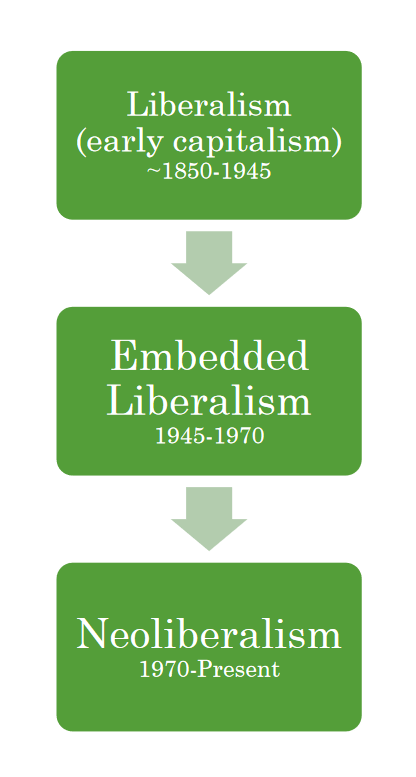
Liberalism → Embedded Liberalism → Neoliberalism
Liberalism: Created massive wealth, but also rampant inequality. This inequality was a major factor in the depth of the depression.
Embedded Liberalism (Keynesian Economics): Due to the depression, labour activists, workers, and the administration of Franklin Delano Roosevelt in the U.S. shifted away from unfettered free market control of the economy. Measures were put in place to strengthen the working class and to stifle inequality while still operating in a broadly capitalist system.
What were the three phases of capitalism?
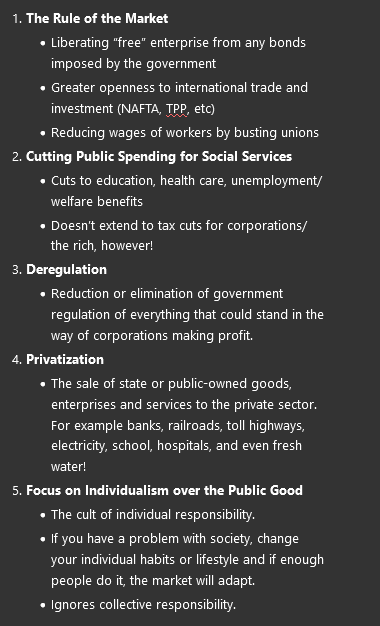
The Rule of the Market
Liberating “free” enterprise from any bonds imposed by the government
Greater openness to international trade and investment (NAFTA, TPP, etc)
Reducing wages of workers by busting unions
Cutting Public Spending for Social Services
Cuts to education, health care, unemployment/welfare benefits
Doesn’t extend to tax cuts for corporations/the rich, however!
Deregulation
Reduction or elimination of government regulation of everything that could stand in the way of corporations making profit.
Privatization
The sale of state or public-owned goods, enterprises and services to the private sector. For example banks, railroads, toll highways, electricity, school, hospitals, and even fresh water!
Focus on Individualism over the Public Good
The cult of individual responsibility.
If you have a problem with society, change your individual habits or lifestyle and if enough people do it, the market will adapt.
Ignores collective responsibility.
What are the five main tenets of neoliberalism?
Neoliberalism has moved beyond the realm of economics and political life and has penetrated the very way we construct ourselves as human subjects. (Suggested by Wendy Brown, following the lead of Michel Foucault.)
Brown argues that a key tenet of modern neoliberalism is its ability to apply the model of the market to every domain of human existence— even where money is not an issue.
For Brown, under neoliberalism, we think and act like contemporary market subjects. (Ex: education, health, fitness, family life, neighbourhood, dating life, etc.)
Neoliberal rationality does not necessarily marketize all spheres of human interaction, although that is an important dimension of the philosophy. Rather, neoliberal rationality propagates the model of the market to all domains and activities. It makes us market actors, always, only, and everywhere.
What is ‘neoliberal rationality’?
Started in 2021 in Buffalo, NY – various stores formed a union under the IWW.
Has now spread to over 490 stores and over 10,000 workers across the U.S. and Canada.
Fights short-staffing, low wages, unpredictable scheduling, harassment, and more.
Starbucks has had a relentless, years long union busting campaign that has cost them over a quarter billion dollars. (But hey, you don’t need a union).
In spite of all its claims to be a “woke” workplace, Starbucks has shown repeatedly it will clamp down on its already underpaid, overworked workforce.
This two-faced approach is emblematic of neoliberalism in 2024 and exists across all industries.
What is ‘Starbucks Workers United’?
We vote for:
Federal Elections (sort of)
Provincial Elections (sort of)
Municipal Elections
Referenda (referendum: a general vote by the electorate on a single political question that has been referred to them for a direct decision. via Oxford Languages)
We DON’T we vote for:
Senate
Cabinet
Governor General
Economic system
What do we vote for in Canada? What do we NOT vote for?
![<ul><li><p><span><strong>The Crown</strong>: Canada is a Constitutional Monarchy</span></p></li><li><p><span><strong>Legislative Branch</strong>: Consists of the Senate and the House of Commons</span></p></li><li><p><span><strong>House of Commons</strong>: this is the only thing we vote on federally (made up of Members of Parliament [MPs])</span></p></li><li><p><span><strong>Senate</strong>: appointed by the PM (usually), through the GG. Mandatory retirement at 75.</span></p></li></ul><div data-youtube-video=""><iframe width="640" height="480" allowfullscreen="true" autoplay="false" disablekbcontrols="false" enableiframeapi="false" endtime="0" ivloadpolicy="0" loop="false" modestbranding="false" origin="" playlist="" src="https://www.youtube.com/embed/7C8uDuhLqvg?si=gFCNqd58fCnUz3Ku" start="0"></iframe></div><p></p>](https://knowt-user-attachments.s3.amazonaws.com/43c48b49-970f-42c7-a1b3-11853e7befa1.png)
The Crown: Canada is a Constitutional Monarchy
Legislative Branch: Consists of the Senate and the House of Commons
House of Commons: this is the only thing we vote on federally (made up of Members of Parliament [MPs])
Senate: appointed by the PM (usually), through the GG. Mandatory retirement at 75.
What does the structure of the federal government look like?
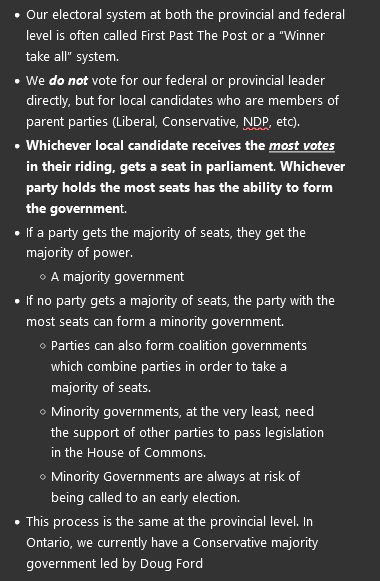
Our electoral system at both the provincial and federal level is often called First Past The Post or a “Winner take all” system.
We do not vote for our federal or provincial leader directly, but for local candidates who are members of parent parties (Liberal, Conservative, NDP, etc).
Whichever local candidate receives the most votes in their riding, gets a seat in parliament. Whichever party holds the most seats has the ability to form the government.
If a party gets the majority of seats, they get the majority of power.
A majority government
If no party gets a majority of seats, the party with the most seats can form a minority government.
Parties can also form coalition governments which combine parties in order to take a majority of seats.
Minority governments, at the very least, need the support of other parties to pass legislation in the House of Commons.
Minority Governments are always at risk of being called to an early election.
This process is the same at the provincial level. In Ontario, we currently have a Conservative majority government led by Doug Ford
What is ‘First Past the Post (FPTP)’ or a ‘Westminster Parliamentary System’?
In 2021, the Federal Liberals failed to gain enough seats to form a majority government, so had to appeal to one of the opposition parties to join then in a “confidence” vote. In this case, the NDP did that, forming a confidence agreement giving them 185 seats in total.
In this case, the NDP and Liberals had to negotiate on the kinds of things the Liberals needed to do to keep the NDP on their side. Federal dental care and pharmacare plans were the biggest things.
What often happens when the winning party wins a minority government?
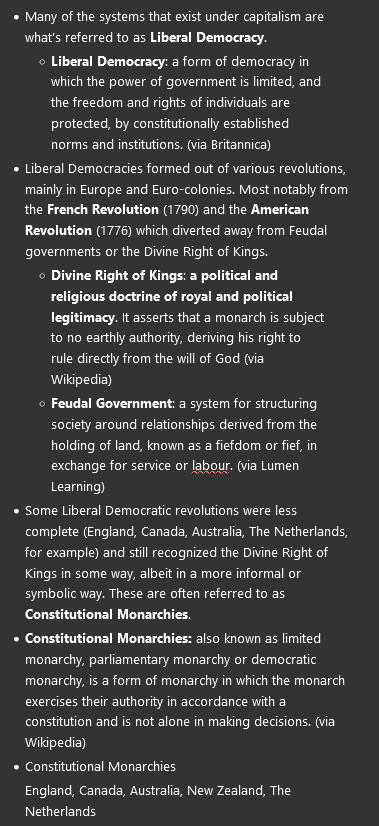
Many of the systems that exist under capitalism are what’s referred to as Liberal Democracy.
Liberal Democracy: a form of democracy in which the power of government is limited, and the freedom and rights of individuals are protected, by constitutionally established norms and institutions. (via Britannica)
Liberal Democracies formed out of various revolutions, mainly in Europe and Euro-colonies. Most notably from the French Revolution (1790) and the American Revolution (1776) which diverted away from Feudal governments or the Divine Right of Kings.
Divine Right of Kings: a political and religious doctrine of royal and political legitimacy. It asserts that a monarch is subject to no earthly authority, deriving his right to rule directly from the will of God (via Wikipedia)
Feudal Government: a system for structuring society around relationships derived from the holding of land, known as a fiefdom or fief, in exchange for service or labour. (via Lumen Learning)
Some Liberal Democratic revolutions were less complete (England, Canada, Australia, The Netherlands, for example) and still recognized the Divine Right of Kings in some way, albeit in a more informal or symbolic way. These are often referred to as Constitutional Monarchies.
Constitutional Monarchies: also known as limited monarchy, parliamentary monarchy or democratic monarchy, is a form of monarchy in which the monarch exercises their authority in accordance with a constitution and is not alone in making decisions. (via Wikipedia)
Constitutional Monarchies
England, Canada, Australia, New Zealand, The Netherlands
What is a ‘liberal democracy’?
A state where the chief executive and representatives are elected, and the rules are set down in a written constitution.
Constitutional Republic
No recognition of Divine Right of Kings
USA, France, Germany, Russia (there are vast differences in types of government here)
USA – Republic/Electoral College
France – Unitary, semi-presidential state
Germany – Parliamentary Republic
What is a ‘constitutional republic’?
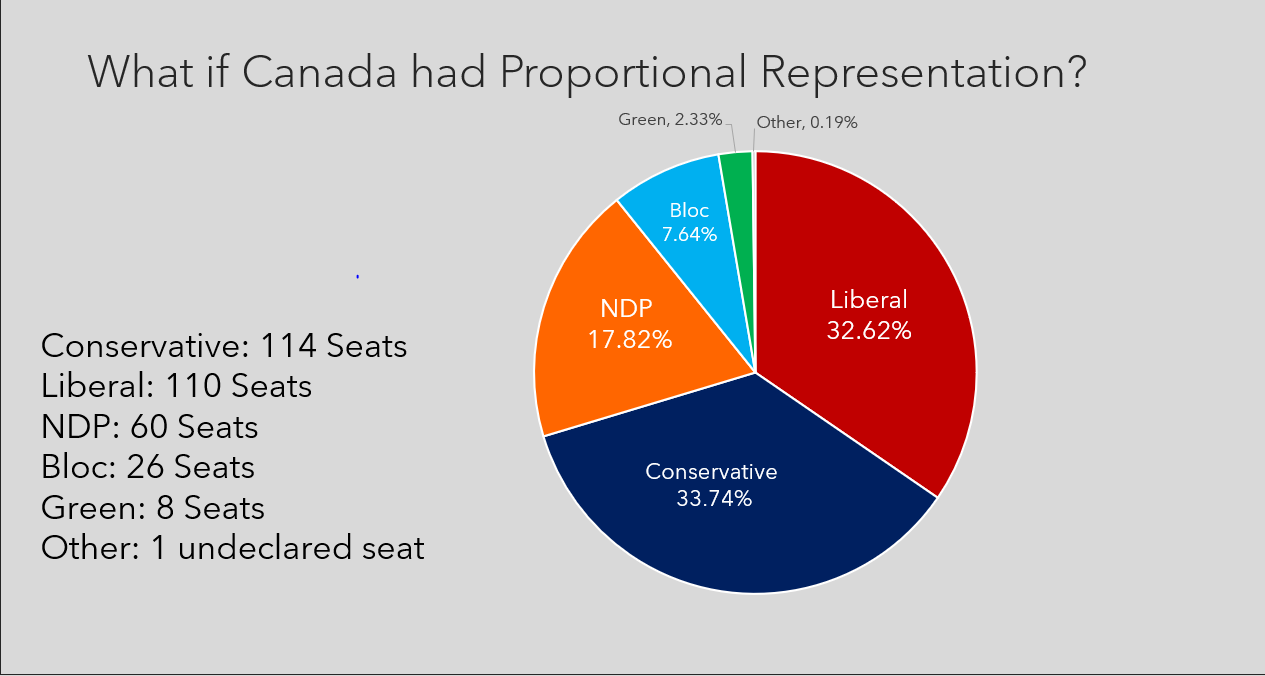
Any type of electoral system under which subgroups of an electorate are reflected proportionately in the elected body. (Wikipedia)
The concept applies mainly to political divisions (political parties) among voters. The essence of such systems is that all votes cast – or almost all votes cast – contribute to the result and are effectively used to help elect someone. (Wikipedia)
Under other election systems, a bare plurality or a scant majority are all that are used to elect candidates. PR systems provide balanced representation to different factions, reflecting how votes are cast. (Wikipedia)
Exists in some forms in Australia
Albania, Argentina, Costa Rica, Denmark, Germany, Greece, Iceland, Ireland, Netherlands (partial), Norway, Portugal, Spain, Sweden, Turkey, and many others.
What is a ‘proportional representation’?
If you voted and your local riding candidate did not win, your vote was “dead” since the winner takes all in each riding.
Nationally, 50.9% of all votes cast were dead
Atlantic Canada – 56.2%
Quebec – 54.2%
Ontario – 53.1%
Western/Northern Canada – 44.6%
36% of ridings had a candidate with over 50% of the vote.
19% had less than 40%
2 ridings had less than 30%
What is a ‘dead vote’?
There are many cogent arguments which claim voting is one of the least important things you can do to implement social change.
History shows us that progressive social change (i.e. social change not ushered in by the wealthy or powerful) is only achieved by grassroots movements and direct action which force politicians and others in power to execute the will of the people
The eradication of feudalism
Civil rights movement
Women’s rights movements
The right to access abortion, equal pay, etc.
Universal Health Care in Canada
Labour Rights
How much does voting actually do?
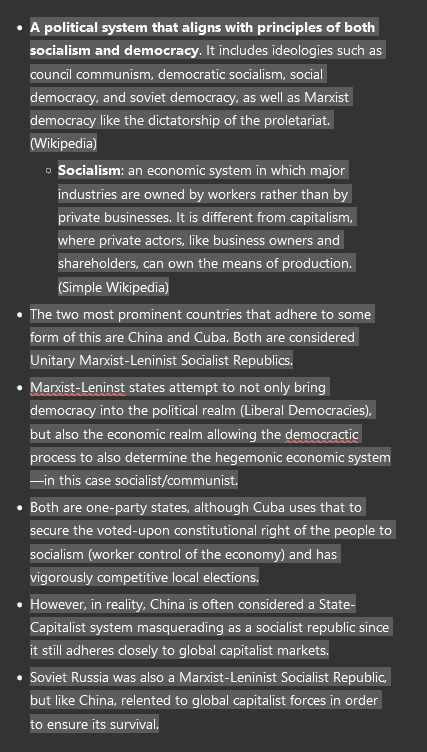
A political system that aligns with principles of both socialism and democracy. It includes ideologies such as council communism, democratic socialism, social democracy, and soviet democracy, as well as Marxist democracy like the dictatorship of the proletariat. (Wikipedia)
Socialism: an economic system in which major industries are owned by workers rather than by private businesses. It is different from capitalism, where private actors, like business owners and shareholders, can own the means of production. (Simple Wikipedia)
The two most prominent countries that adhere to some form of this are China and Cuba. Both are considered Unitary Marxist-Leninist Socialist Republics.
Marxist-Leninst states attempt to not only bring democracy into the political realm (Liberal Democracies), but also the economic realm allowing the democractic process to also determine the hegemonic economic system—in this case socialist/communist.
Both are one-party states, although Cuba uses that to secure the voted-upon constitutional right of the people to socialism (worker control of the economy) and has vigorously competitive local elections.
However, in reality, China is often considered a State-Capitalist system masquerading as a socialist republic since it still adheres closely to global capitalist markets.
Soviet Russia was also a Marxist-Leninist Socialist Republic, but like China, relented to global capitalist forces in order to ensure its survival.
What is a ‘socialist democracy’?
Unlike Provincial and Federal elections, local municipal elections are a form of more direct democracy since you vote for both a hyper-local councilor AND the mayor directly.
However, Doug Ford has given strong mayor powers to a few of the more populous regions in Ontario which heavily nullifies the role of councilors in decision-making.
Typically, councilors (at least in sizable cities and towns) come from specific wards in the city.
Smaller towns usually elect a certain number of councilors by cascading vote.
What is unique about municipal elections?
Political parties in Canada do not represent the full range of political choice.
Not voting demonstrates a lack of confidence in or knowledge of the democratic system.
Even voter apathy is an important data point
If voters are apathetic or do not have the time/energy to engage in the system, that tells us that neoliberal capitalism is not providing people the tools or capacity to consider electoral politics important to them.
Why is NOT voting an act of civic engagement?
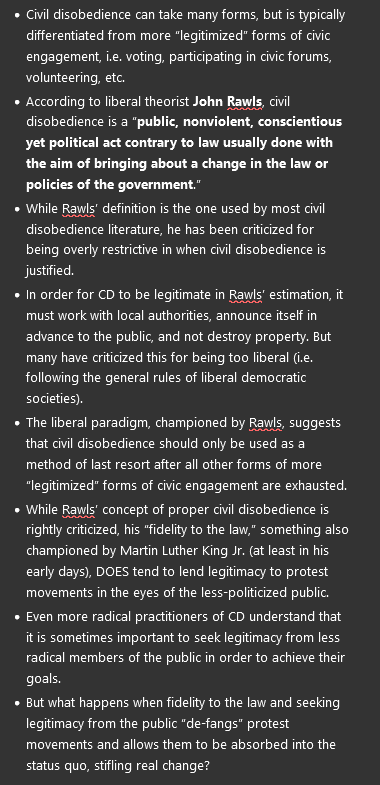
Civil disobedience can take many forms, but is typically differentiated from more “legitimized” forms of civic engagement, i.e. voting, participating in civic forums, volunteering, etc.
According to liberal theorist John Rawls, civil disobedience is a “public, nonviolent, conscientious yet political act contrary to law usually done with the aim of bringing about a change in the law or policies of the government.”
While Rawls’ definition is the one used by most civil disobedience literature, he has been criticized for being overly restrictive in when civil disobedience is justified.
In order for CD to be legitimate in Rawls’ estimation, it must work with local authorities, announce itself in advance to the public, and not destroy property. But many have criticized this for being too liberal (i.e. following the general rules of liberal democratic societies).
The liberal paradigm, championed by Rawls, suggests that civil disobedience should only be used as a method of last resort after all other forms of more “legitimized” forms of civic engagement are exhausted.
While Rawls’ concept of proper civil disobedience is rightly criticized, his “fidelity to the law,” something also championed by Martin Luther King Jr. (at least in his early days), DOES tend to lend legitimacy to protest movements in the eyes of the less-politicized public.
Even more radical practitioners of CD understand that it is sometimes important to seek legitimacy from less radical members of the public in order to achieve their goals.
But what happens when fidelity to the law and seeking legitimacy from the public “de-fangs” protest movements and allows them to be absorbed into the status quo, stifling real change?
What is ‘civil disobedience’?
Liberal protest movements tend to get absorbed into the very power structures they’re looking to change, leading to reformist or surface changes at best and to no change or a regressive situation at worst.
For Rawls and other liberal CD theorists, CD should be limited to the realm of the political and never become about economic reforms since legitimacy is difficult to suss out because those acting on economic issues could be “self-interested.” But of course, this limiting of what legitimate CD is, reinforces….
…CAPITALISM AS THE ONLY TRUE AND RIGHTEOUS ECONOMIC SYSTEM and instead focuses on issues of individual identity and equal liberty.
How much legitimacy for civil disobedience should be sought, and from who?
Yes.
Candice Delmas argues that citizens have a civic duty to disobey unjust laws and institutions and that it ought not to be civil.
She says “covert, evasive, violent, or offensive” uncivil disobedience can also be legitimate, especially if the target of such uncivil acts has a deleterious effect on the majority of people.
“…liberal (and sometimes more radical) civil disobedience offers a way of doing disruptive protest in a way that has the potential to be broadly accepted as legitimate, because of how it relates to the state, democracy, and the rule of law within a largely reformist framework with little to say about political economy.” (Berglund, pg. 4, emphasis mine)
Can UNcivilized disobedience be considered “legitimate”?
No.
Rosa Luxemburg argued in her 1899 pamphlet “Social Reform or Revolution” that while social reforms can help working people gain class consciousness, they ultimately cannot liberate the working class from the oppressions of capitalism.
She argued that the working class must recognize that capitalism creates the seeds for its own destruction and that revolution is necessary to transform capitalism into socialism.
Social reform: reshaping and reforming culturally accepted laws and norms in light of new cultural paradigms. (study.com)
Revolution: a sudden, radical, or complete change; a fundamental change in political organization. (Merriam-Webster)
Are social reforms as effective, of not more effective, than revolutions?
A concept developed largely within the anarchist tradition; a form of disruptive, prefigurative protest.
Direct action is an inherently revolutionary form of disruptive protest since it seeks to undermine the power of the state and capital and execute the creative will of the working class in constructing alternatives to liberal democracies and to capitalism.
DA can also be differentiated from civil disobedience in that it involves placing bodies into the gears of capital (i.e. people directly placing themselves in the path of capital flows).
Civil disobedience is largely symbolic and typically allowed by authority to some degree (which doesn’t mean it’s always necessarily less effective, just less radical in its aims).
What is ‘direct action’?
A concept honed by Italian Marxist Antonio Gramsci among others; involves thinking about politics in a two-fold way: what institutions in society need to be destroyed to envision a better future? And what does that future look like? In other words, prefigurative politics must involve an imagining of what comes after the disruptive protest, constituted in the present.
What are ‘prefigurative politics’?
Most symbolic action taken by people is tolerated by the state.
Direct action, on the other hand, because it directly undermines the state and the flow of capital, is often violently oppressed by state authorities (police, military, Pinkertons, private security, etc.).
For those wishing to perform direct action, understanding the consequences of those action is of utmost importance.
Planning, inoculation, and training are very important.
Is direct action as tolerated by the state as symbolic action?
False.
Because all direct action involves risk of police/state violence, and because it sometimes involves the destruction of property or violence, practitioners must be aware of the potential ethical dilemmas of such action.
What is the risk/reward? If property is to be destroyed or damaged, whose is it? If there is a risk of violence, whom is that violence directed at?
These questions are not to be taken lightly and never are in revolutionary scenarios.
They must adhere to principles of social justice and care for vulnerable people, ALWAYS.
True or False: Direct action comes without consideration of ethics and consequence.